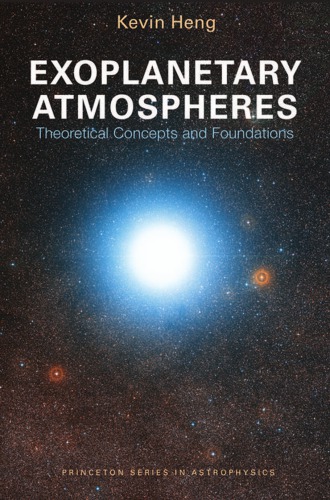


Title: Exoplanetary Atmospheres: Theoretical Concepts and Foundations | Author(s): Kevin Heng | Publisher: Princeton University Press | Year: 2017 | Language: English | Pages : 291 | Size: 5 MB | Extension: pdf
The study of exoplanetary atmospheres-that is, of planets orbiting stars beyond our solar system-may be our best hope for discovering life elsewhere in the universe.
Exoplanetary Atmospheres covers the physics of radiation, fluid dynamics, atmospheric chemistry, and atmospheric escape. It draws on simple analytical models to aid learning, and features a wealth of problem sets, some of which are open-ended. This authoritative and accessible graduate textbook uses a coherent and self-consistent set of notation and definitions throughout, and also includes appendixes containing useful formulae in thermodynamics and vector calculus as well as selected Python scrs.
Table of Contents
Foreword by Sara Seager xi
Preface xiii
1 Observations of Exoplanetary Atmospheres: A Theorist’s Review of Techniques in Astronomy 1
1.1 The birth of exoplanetary science 1
1.2 Transits and occultations 2
1.3 Radial velocity measurements 8
1.4 Direct imaging 11
1.5 Gravitational microlensing 12
1.6 Future missions and telescopes 12
2 Introduction to Radiative Transfer 14
2.1 The optical depth: The most fundamental quantity in radiative transfer 14
2.2 Basic quantities in radiative transfer 16
2.3 The radiative transfer equation 20
2.4 Simple solutions of the radiative transfer equation 20
2.5 A practical checklist for radiative transfer calculations 23
2.6 Clouds 24
2.7 Atmospheric retrieval 27
2.8 Problem sets 31
3 The Two-Stream Approximation of Radiative Transfer 35
3.1 What is the two-stream approximation? 35
3.2 The radiative transfer equation and its moments 36
3.3 Two-stream solutions with isotropic scattering 39
3.4 The scattering phase function 45
3.5 Two-stream solutions with non-isotropic scattering 46
3.6 Different closures of the two-stream solutions 49
3.7 The diffusion approximation for radiative transfer 51
3.8 Problem sets 53
4 Temperature-Pressure Profiles 56
4.1 A myriad of atmospheric effects: Greenhouse warming and antigreenhouse cooling 56
4.2 The dual-band or double-gray approximation 57
4.3 The radiative transfer equation and the scattering parameter 58
4.4 Treatment of shortwave radiation 60
4.5 Treatment of longwave radiation 64
4.6 Assembling the pieces: Deriving the general solution 65
4.7 Exploration of different atmospheric effects 67
4.8 Milne’s solution and the convective adiabat 71
4.9 Problem sets 72
5 Atmospheric Opacities: How to Use a Line List 74
5.1 From spectroscopic line lists to synthetic spectra 74
5.2 The Voigt profile 76
5.3 The quantum physics of spectral lines 78
5.4 The million- to billion-line radiative transfer challenge 81
5.5 Different types of mean opacities 88
5.6 Problem sets 89
6 Introduction to Atmospheric Chemistry 92
6.1 Why is atmospheric chemistry important? 92
6.2 Basic quantities: Gibbs free energy, equilibrium constant, rate coefficients 93
6.3 Chemical kinetics: Treating chemistry as a set of mass conservation equations 101
6.4 Self-consistent atmospheric chemistry, radiation and dynamics: A formidable computational challenge 106
6.5 Problem sets 107
7 A Hierarchy of Atmospheric Chemistries 110
7.1 A hierarchy of models for understanding atmospheric chemistry 110
7.2 Equilibrium chemistry with only hydrogen 110
7.3 Equilibrium C-H-O chemistry: Forming methane, water, carbon monoxide and acetylene 113
7.4 Equilibrium C-H-O chemistry: Adding carbon dioxide 115
7.5 Equilibrium C-H-O chemistry: Adding ethylene 121
7.6 Problem sets 122
8 Introduction to Fluid Dynamics 123
8.1 Why is the study of fluids relevant to exoplanetary atmospheres? 123
8.2 What exactly is a fluid? 124
8.3 The governing equations of fluid dynamics 124
8.4 Potential temperature and potential vorticity 128
8.5 Dimensionless fluid numbers 130
8.6 Problem sets 132
9 Deriving the Governing Equations of Fluid Dynamics 135
9.1 Preamble 135
9.2 The mass continuity equation (mass conservation) 135
9.3 The Navier-Stokes equation (momentum conservation) 136
9.4 The thermodynamic equation (energy conservation) 138
9.5 The conservation of potential vorticity 139
9.6 Various approximate forms of the governing equations of fluid dynamics 143
9.7 Magnetohydrodynamics 147
9.8 Problem sets 151
10 The Shallow Water System: A Fluid Dynamics Lab on Paper 155
10.1 A versatile fl
مبلغ قابل پرداخت 26,000 تومان
برچسب های مهم